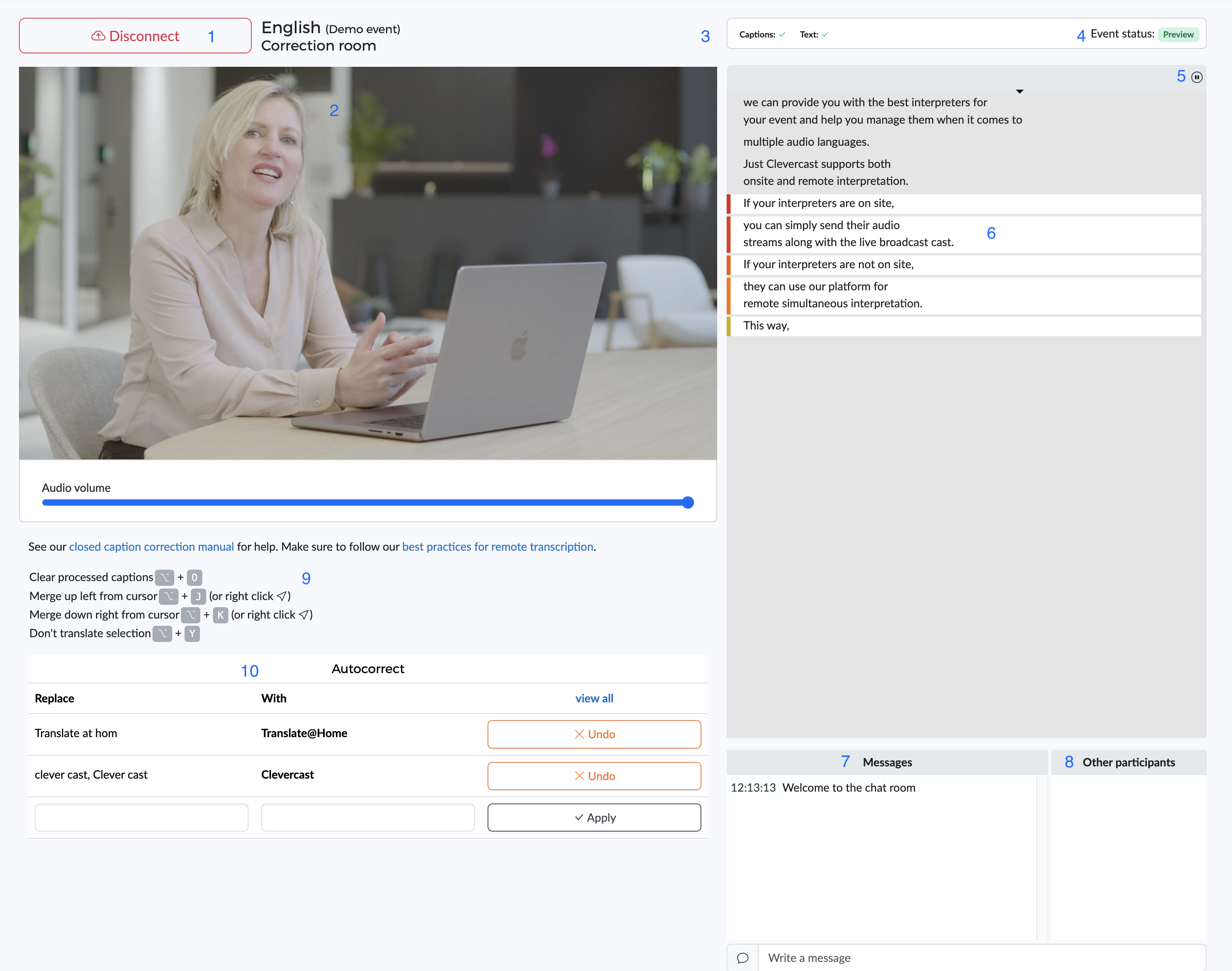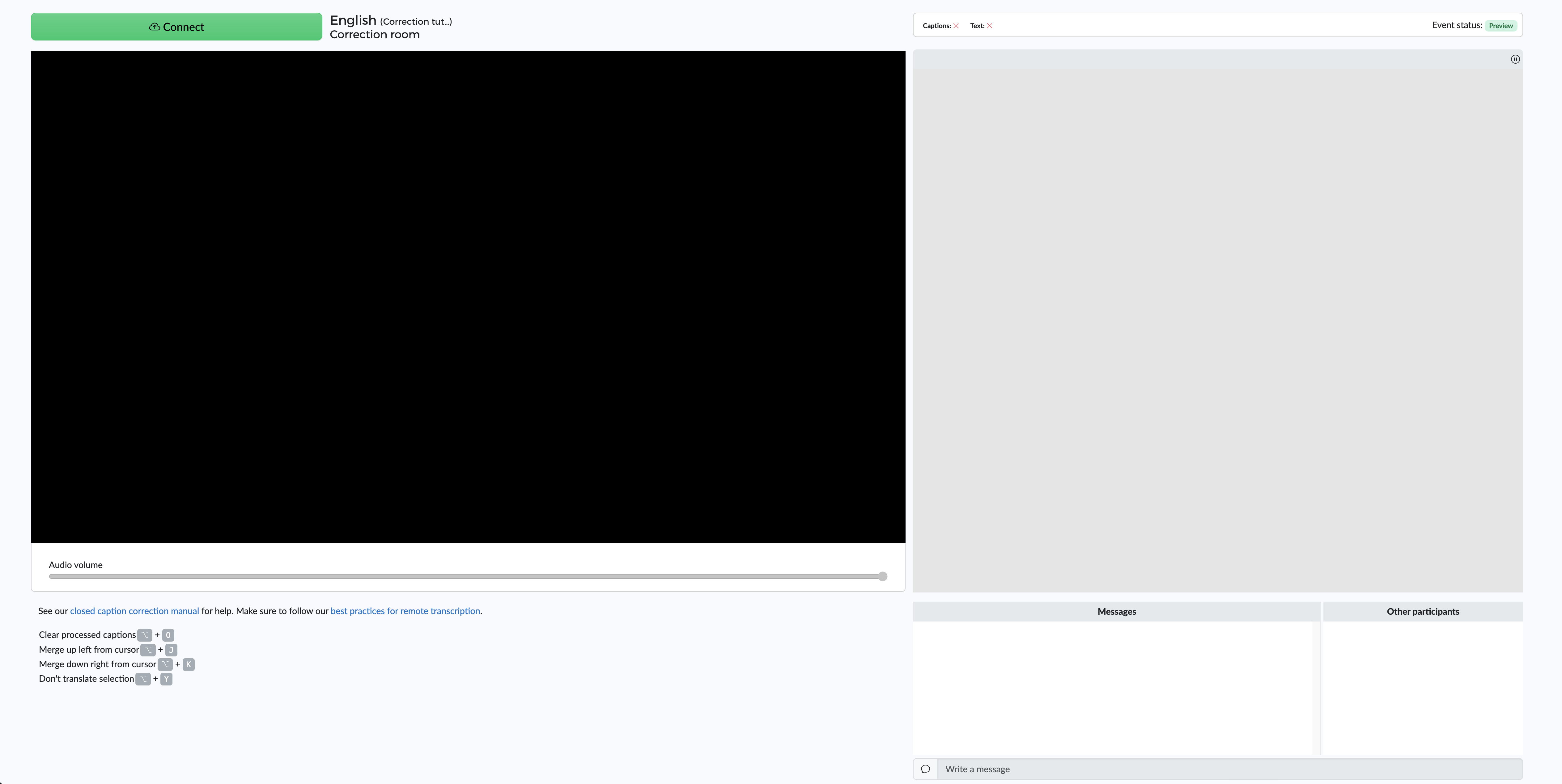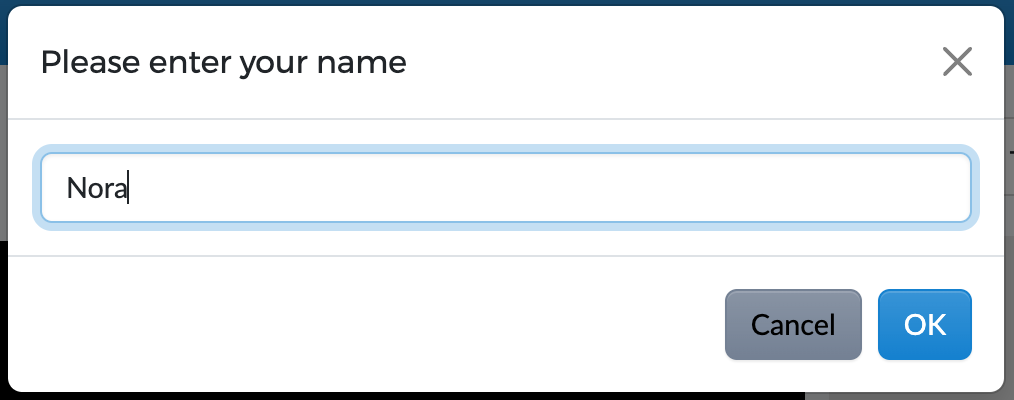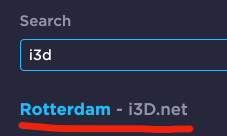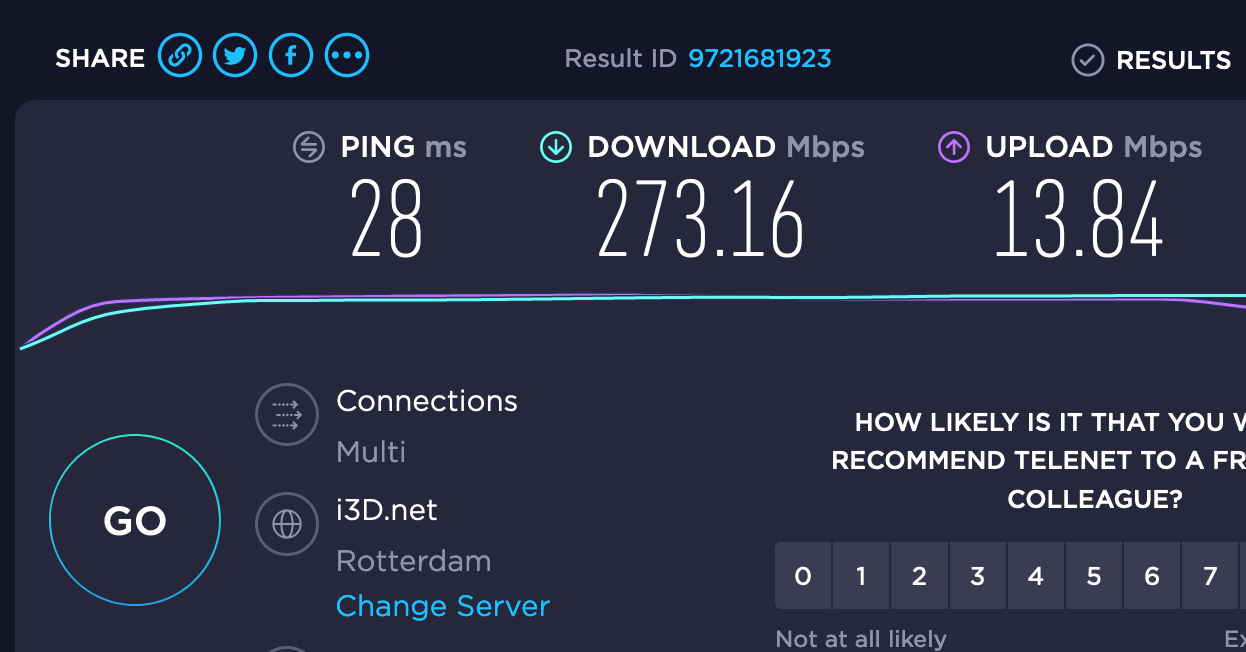Closed Captions Correction manual
Introduction
This manual is intended for people using Clevercast to edit closed captions which are either a result of speech-to-text conversion by AI or human transcription. This room allows for correction before the captions are translated, used to generate audio languages and added to the live stream. The interface is called a Corrector Room.
The room can be used to watch the incoming video stream and listen to the floor audio. In live streams with simultaneous audio translation, correctors can also use interpreter relay. The text chat on the bottom of the page allows for communication with event managers and other users.
The person using the room should receive a secure link from the event manager.
Important: make sure to read the requirements and best practices before you start using the correction room.
The Correction Room interface
This is the interface used for the editing of closed captions. If you are an editor, you will receive a secure link to your language’s Correction Room from the event’s manager. By using this link in Firefox (or a different browser), you automatically get access to the room. The user interface looks like this:
The interface consists of the following elements:
- Connect/Disconnect button: before a user can start working, they have to connect to the correction room (in order to receive the incoming stream and send outgoing text).
- Player: plays the video and floor audio as soon as it is being broadcast.
- Connection status: displays the status of the incoming captions and the outgoing text.
- Event status: the live event status. In order to make the room available for use, it is set to
Preview(for testing in advance, viewers can not see or hear the live stream),Started(live) orPaused(viewers can not see or hear the live stream). If set toInactiveorEnded, the room is not available. - Disable/enable captions button: (temporarily) disable captions from being sent to the stream.
- Captions: a separate box is shown for each closed caption. By editing the text in these boxes, you can correct the closed captions before they are shown in the video player.
- Messages window: allows a user to communicate with other transcribers for the same language and with their event managers. It also contains system messages (e.g. when someone joins or leaves the room).
- Participants window: names of other users for the same language.
- Keyboard shortcut list: use these custom shortcuts during correcting.
- Search and replace function: replace incorrect spelling of words with the correct spelling.
Using the Correction Room
After receiving the link to the Correction Room, a user should follow these steps:
1) Copy the link to your browser (preferably Firefox) to go to your proper Correction Room.
2) Press the Connect button: Clevercast will ask you to fill in your name for the text chat. Other users and event managers will see your name in the ‘Other Participants’ dialog.
3) After filling out your name, you will be connected. You should now see green check marks for both captions and text. When the video broadcast is started, your video will automatically start playing.
The text chat can be used to communicate with other users for the same language or the managers of your event. On the right side, you can see other users of your transcription room.
The correction process
To begin correcting a caption, just click on a caption and start typing. The caption you clicked on will be visually highlighted.
Each caption has a color code indicating how much time you have left for correction:
- Red means time is almost up for correcting this caption, and that it will soon be pushed to the stream.
- Orange means you have some time left, but if you want to make corrections to this caption, you should make them soon.
- Green means you still have plenty of time left.
- Grey means the caption has been sent to the stream and can’t be adjusted anymore.
The caption correction interface supports the same basic text editing techniques familiar to word processors. Double click to select a word, triple click to select a sentence. Basic visual formatting is also supported, with Ctrl + B for bold and Ctrl + I for italic, and Ctrl + U for underline.
Navigation between captions
| Mac | Windows | |
| Next caption | Tab | Tab |
| Previous caption | Shift + Tab | Shift + Tab |
Editing
The following shortcuts are custom shortcuts, created specfically for use in the Correction Room.
| Mac | Windows | |
| Merge with previous caption (starting from cursor's location) | Option + J | Ctrl + J |
| Merge with next caption (starting from cursor's location) | Option + K | Ctrl + K |
| Don't translate (prevent the term from being translated in the additional caption languages) | Option + Y | Ctrl + Y |
| Clear processed captions | Option + O | Ctrl + O |
| Change the capitalisation between lower case, first letter, and upper case | N.A. | Shift + F3 |
Note: After using the Don't translate shortcut, it can take up to 10 seconds before the word (group) is added to the AI vocabulary. It can therefore still appear in the stream unadjusted shortly after using the shortcut.
Some of the standard shortcuts are also available.
| Mac | Windows | |
| Move cursor to beginning of current or previous word | Option + ← (left arrow) | Ctrl + ← (left arrow) |
| Move cursor to end of current or next word | Option + → (right arrow) | Ctrl + → (right arrow) |
| Delete previous word | Ctrl + Option + Delete | Ctrl + Backspace |
| Delete next word | N.A. | Ctrl + Delete |
| Select all text | Cmd + A | Ctrl + A |
Formatting
| Mac | Windows | |
| Bold | Ctrl + B or Cmd + B | Ctrl + B |
| Italic | Ctrl + I or Cmd + I | Ctrl + I |
| Underline | Ctrl + U | Ctrl + U |
Automating Instructions
To avoid having to make the same correction multiple times, the correction room lets you send instructions to the AI captioning process. This way, a specific correction can be automated, so you no longer have to do it yourself.
When you do this, the AI Vocabulary for this live stream is updated. You can also use AI vocabulary interface to manage AI instructions, both before and during the live stream.
Autocorrect terms (search & replace)
If you replace a term by another one, both terms will automatically appear in the Autocorrect panel in the bottom-left corner, as a 'search & replace' suggestion. Press the Apply button to add the term to the AI vocabulary for auto-correction.
If a term consists of 5 characters or more, and you only change 3 characters or less, Clevercast automatically applies the correction (instead of showing it as a suggestion). In that case, you can still press the Undo button (if undesired).
In the image above, two 'search & replace' terms are shown:
- Replace
translate at homebyTranslate@Home: this is already applied. Press the 'Undo' button to cancel the automatic replace. - Replace
clevercastbyClevercast: this is not yet applied. Press the 'Apply' button to ensure automatic replace.
Capital letters
Search terms are case-insensitive. E.g. the search term clever cast will also result in Clever cast and CLEVER CASt to be replaced.
Replace terms can only be capitalised in a single way. E.g. once the replace term FFmpeg is added, it is no longer possible to add ffmpeg or FFMpeg as a replace term (unless you first delete FFmpeg from the vocabulary).
Every occurrence of the replace term itself will also get this capitalisation (e.g. ffmpeg will automatically become FFmpeg). So there is no need to add extra search terms to enforce a term's capitalisation. In fact, if you try this, Clevercast will tell you that the term is already in the vocabulary.
Summarised: the capitalisation of a replace term is always applied exactly, regardless of its position in a sentence. The only exception is when a sentence starts with a lowercase term.
- If a replace term contains capital letter(s), they will always be capitalised no matter where in the sentence.
- If a replace term starts with a lowercase letter, it will only be capitalised at the start of a sentence.
So if a corrected term starts with an uppercase letter only because it is at the beginning of the sentence, you must change its first letter to lowercase before pressing 'Apply'.
Manually adding terms
The autocorrect list contains the five most recent suggestions and corrections. In addition, you can also type search & replace terms yourself. There are two advanced cases (for convenience):
- Leaving the 'search' term empty: this can be used to control capitalisation of the 'replace' term. For example, to make sure that
FFmpegalways gets the correct capitalisation. - Leaving the 'replace' term empty: this can be used to remove certain words from the closed captions. Be careful using this, since auto-removing words may cause sentence structure or punctuation to become incorrect.
The Vocabulary interface
Clevercast prevents you from adding the same term multiple times, and from adding contradictory terms. In that case, you will see an error message. Note that some terms may have been added to the AI Vocabulary before the live stream starts.
The AI vocabulary interface provides you with an overview of all autocorrect terms. In exceptional cases, you'll need it to correct previous mistakes, since the correction room doesn't allow you to delete existing vocabulary entries.
Don't translate function
Note: this is only applicable if the event includes text-to-text translation of the closed captions into other languages.
A corrector can, after selecting a term in the text, use the 'Don't translate' shortcut (Ctrl + Y for Windows, Option + Y for Mac - see Editing). This instructs the AI engine, when it converts the captions into other languages, to leave that particular term 'as is'.
That way, you avoid (less familiar) names or brands being translated (if a term is well known, the AI engine knows whether to translate it or not). E.g. if a local brand is named 'Sun Shield', you don't want it to appear as 'Zonneschild' in the Dutch version of the closed captions.
Once you have used this shortcut, the term will appear highlighted in the text. This tells you that custom translations have already been set for this term (which can also be done before the live stream starts through the AI vocabulary interface). In that case, using the shortcut for this term will no longer have effect.
Requirements
Computer
We recommend a recent computer, preferably high-end or at least mid-range with a fast processor and sufficient memory (e.g. Intel i7 with 16GB RAM) and a dedicated sound card and graphic card.
Browser
The operating system doesn’t matter. It should only be able to run a recent version of the Mozilla Firefox browser (make sure to install the latest update).
We recommend using Firefox. Other browsers with WebRTC support, like Google Chrome, should also work, but we recommend using Firefox for a number of reasons:
- We use Firefox ourselves for testing.
- Google Chrome is more commonly used for everyday browsing. There is a higher chance of add-ons being installed that could affect performance.
If for some reason a translator can’t use Firefox, you could try using Google Chrome instead.
Headset
To listen to the incoming audio, we recommend using a professional headset.
Fast and stable connection to Clevercast servers
A wired internet connection is required for audio translation. A good wireless connection could suffice for transcription. But we still recommend using an ethernet connection if possible, since it will ensure that the connection will remain fast and stable during the entire event.
Users need a fast and stable internet connection to the Clevercast streaming servers located in the Netherlands.
To test this, you should receive a link to the Translate@Home Connection Test page from your project manager. This way, you can test the quality of your connection in advance.
After receiving the link, open your browser (close all unnecessary other applications) and paste the test link in the address bar. The test page will ask you to enter your name, email and location and press the Start button. The browser will establish a connection with Clevercast and start sending data packets for about 30 seconds.
After 30 seconds, the test ends and you will see a popup with the result. The details of your test will also be made available to your project manager.
Sufficient bandwidth
Users should have a bandwidth of at least 5 Mbps down. If you're not sure, make sure to test beforehand or check your available bandwidth by going to https://www.speedtest.net/. Click on the Change Server link and type ‘I3D’ in the popup dialog and select ‘Rotterdam – I3D.net’. Finally, press the GO button and wait until all tests are completed.
The Download Mbps value should be higher than 5 Mbps, otherwise you may experience difficulties in watching the original video + audio stream.
The PING and Upload Mbps value are less important (the Translate@Home Connection Test provides sufficient info).
Best practices
Make sure the latest Firefox version is installed
Do this before you start testing. Then go to the translator room and check if you can connect to video, audio and chat.
Notes:
- The OpenH264 video codec (offered by Cisco Systems, Inc) should be enabled in the Firefox plug-ins. This is the case by default. If you can’t see the video in Firefox (black screen) this plug-in is probably not enabled. Try enabling it or do a fresh install of Firefox.
- If you are unable to use Firefox and you have a high-end computer, you can also use Google Chrome (after testing).
Restart your computer and close all other applications
To make sure your computer is stable, restart it before translating. When you’re ready to start, close all unnecessary applications to prevent them from using your processor, memory or internet connection. Make sure the Operating System is not allowed to start or download automatic upgrades.
Don't use multiple browser tabs
Avoid opening rooms in multiple tabs. This can result in problems with your connections or audio quality.
Test extensively
Make sure to test beforehand with a stream that has comparable audio settings. While you’re testing, the event manager should listen and help you to set the volume of your microphone.
Reconnect if a connection problem persists
If a problem (e.g. local network issue) occurs during the event, the audio of your translation will restore itself in most cases. If it doesn’t, you should quickly reconnect (press the disconnect button and then connect again).
